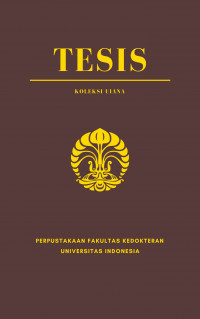Tesis
Korelasi HbA1C dan GDS dengan Hypoxia Inducible Factors 1 Alpha (HIF-1α) Pada Penderita Diabetic Foot Ulcer = Correlation of HbA1C and GDS with Hypoxia Inducible Factors 1 Alpha (HIF-1α) in Diabetic Foot Ulcer Patients.
Latar Belakang: DM merupakan salah satu penyebab morbiditas dan mortalitas tertinggi di dunia, dengan 15-25% pasien akan berkomplikasi menjadi DFU. Data pada tahun 2003 di RSCM menunjukkan bahwa angka kematian akibat DFU adalah 16% dan angka amputasi mencapai 25%. Hingga saat ini belum terdapat strategi tatalaksana DFU yang efektif karena patogenesis molekular yang menyebabkan kegagalan penyembuhan luka masih belum sepenuhnya dipahami. Selain itu pengendalian kadar glukosa darah dalam pengobatan DFU masih belum jelas dan menjadi perdebatan dalam berbagai studi. Tujuan: Penelitian ini bertujuan untuk menganalisis hubungan HbA1c dan GDS dengan faktor angiogenesis HIF-1α, sehingga dapat dijadikan dasar dalam melakukan tata laksana yang tepat untuk pasien DFU. Metode: Desain penelitian potong lintang. Subjek penelitian pasien DFU yang berobat ke RSCM, diambil data dasar (jenis kelamin dan usia), pemeriksaan klinis (TB, BB, dan IMT), pemeriksaan laboratorium (GDS, HbA1c). HIF-1α diperiksa dari sampel biopsi jaringan luka DFU saat operasi debridemen dan amputasi dengan pemeriksaan ELISA. Data dilakukan uji normalitas Saphiro-Wilk dan uji normalitas Kolmogorov Smirnov, dilanjutkan uji korelasi Spearman. Pengaruh variabel perancu dianalisa dengan uji mann whitney dan tes regresi linear sederhana. Hasil: Terdapat 64 pasien yang memenuhi kriteria inklusi dan dilakukan pemeriksaan kadar HiF1α dari sampel jaringan biopsi. Data karakteristik didapatkan hasil kelompok dominan perempuan (54.7%) dengan usia rerata 55.7 ± 10.4 tahun, IMT median 24.9 kg/m² (overweight 48.2%, obesitas 34.6%), dan komorbid anemia (84.3%). Karakteristik laboratorium, GDS median 220 (14-705)mg/dL dengan kelompok kondisi hiperglikemik > 200 mg/dL sebanyak 54.7%. HbA1c median 7.7(4.1-13.7)% dengan kelompok kontrol gula darah buruk HbA1c > 6.5% sebanyak 85.8%. Tidak didapatkan korelasi bermakna antara GDS dengan HIF-1α p 0.523(p > 0.05). Tidak didapatkan korelasi yang bermakna antara HbA1c dengan HIF-1α p 0.792(p > 0.05). Didapatkan variable perancu yang bermakna pada kondisi derajat luka DFU p 0.03 (p < 0,05). Kesimpulan: Hasil penelitian ini menunjukkan bahwa baik HbA1c atau GDS tidak mempunyai hubungan yang bermakna dengan kadar HiF-1α. Variabel perancu kondisi derajat luka DFU berpengaruh secara signifikan terhadap ekspresi HIF-1α.
Kata Kunci: Diabetic Foot Ulcer; GDS, HbA1c, HIF-1α
Background: DM is one of the leading causes of morbidity and mortality in the world, with 15-25% of patients developing complications of DFU. Results data in 2003 at the RSCM showed that the mortality rate from DFU was 16% and the amputation rate was 25%. There is no effective DFU management strategy because the molecular pathogenesis that causes wound healing failure is still not fully understood. In addition, the control of blood glucose levels in the treatment of DFU is still unclear and has been debated in various studies. Objective: This study aims to analyze the relationship between HbA1c and GDS with the angiogenesis factor HIF-1α, so that it can be used as a basis for appropriate management of DFU patients. Methods: The research design was cross sectional. Body mass index, comorbid disease status were recorded. The laboratory parameters GDS, HbA1c and HiF-1a expression examined in the laboratory. Test the normality data by the Saphiro-Wilk test and the Kolmogorov Smirnov test, followed by the Spearman correlation test. The effect of confounding variables was analyzed by Mann Whitney test and simple linear regression test. Results: There were 64 patients who met the inclusion criteria and were examined for HiF1α levels from biopsy tissue samples. Characteristic data showed that the dominant group was female (54.7%) with a mean age of 55.7 ± 10.4 years, median BMI 24.9 kg/m² (overweight 48.2%, obesity 34.6%), and comorbid anemia (84.3%). Laboratory characteristics, the median GDS of 220 (14-705)mg/dL with the hyperglycemic condition group > 200 mg/dL as much as 54.7%. The median HbA1c was 7.7(4.1-13.7)% with the bad blood sugar control group HbA1c > 6.5% as much as 85.8%. There was no significant correlation between GDS and HIF-1α p 0.523 (p > 0.05). There was no significant correlation between HbA1c and HIF-1α p 0.792 (p > 0.05). A significant confounding variable was found in the condition of the degree of wound DFU p 0.03 (p < 0.05). Conclusion:The results of this study showed that neither HbA1c nor GDS had a significant correlation with HiF-1α . The confounding variable of DFU wound degree had a significant effect on the expression of HIF-1α
Keywords: Diabetic Foot Ulcer; GDS; HbA1c; HIF-1α
- Judul Seri
-
-
- Tahun Terbit
-
2021
- Pengarang
-
Iwan Budi Kristanto - Nama Orang
Aria Kekalih - Nama Orang
Patrianef - Nama Orang - No. Panggil
-
T21431fk
- Penerbit
- Jakarta : Sp-2 Ilmu Bedah Vaskular dan Endovaskular., 2021
- Deskripsi Fisik
-
xvi, 56 hlm. ; 21 x 30 cm
- Bahasa
-
Indonesia
- ISBN/ISSN
-
-
- Klasifikasi
-
NONE
- Edisi
-
-
- Subjek
- Info Detail Spesifik
-
Tanpa Hardcopy
| T21431fk | T21431fk | Perpustakaan FKUI | Tersedia |


Masuk ke area anggota untuk memberikan review tentang koleksi